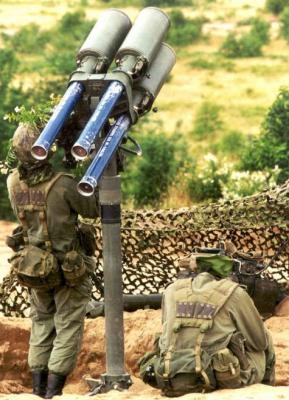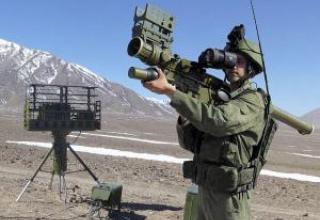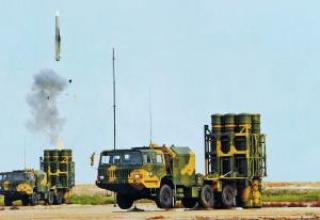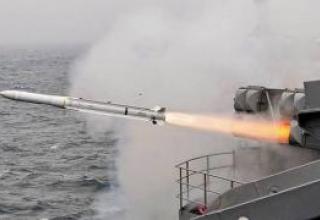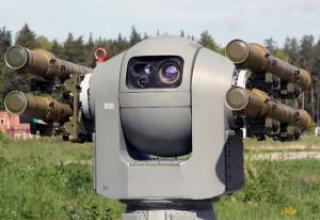Portable anti-aircraft missile system (MANPADS) "Starburst" is designed to engage a wide class of air attack vehicles (including those flying at low and extremely low altitudes), destroy lightly armored ground and surface targets.
The Starburst complex (originally called Javelin S15) was developed by Thales Air Defence Ltd in the mid-1980s by order of the British Ministry of Defence and represents a further development of the Blowpipe family of man-portable air defence systems - Javelin by this company. In contrast to its predecessors, the complex is equipped with a laser optical guidance system originally developed for Starstreak man-portable air defense systems, has increased noise immunity and efficiency.
Along with the portable version, a number of Starburst complex modifications have been developed. Thales Air Defence Ltd" man-portable air defence systems have a much larger mass than similar anti-aircraft systems equipped with missiles with infrared sensors (such as "Needle", "Stinger"), so "Starburst" is mainly used with a light multi-channel launcher, as well as placed on various vehicles or surface ships.
In 1986, the complex was adopted by the British Army, and the first deliveries were made at the same time. Rapid deployment began in early 1990, when "Starburst" replaced the man-portable air defence system "Javelin" and entered into service of regular and reserve army units.
The complex is in service with the UK, Malaysia and Canada. In 1994 it was announced that the Kuwaiti Ministry of Defense decided to purchase the Starburst missile system, which included thermal imaging cameras by Pilkington, allowing to conduct combat operations day and night.
The Starburst SAM system was used during Operation Desert Storm, where 10 batteries of the Royal Artillery 40th Field Regiment were deployed and remained 100 per cent operational during the war.
Composition:
In the portable version of the complex "Starburst" consists of two parts: a missile in the TPC and an attached sighting device. The "Starburst" rocket is solid fuel, two-stage. The combat unit is shrapnel-flagged, equipped with contact and non-contact fuses. The control system is placed in the main part of the missile. In the tail of the missile are stabilizers, which are placed two transceivers of laser guidance system. Each of the transceiver units includes a laser receiver, signal processor and transmitter, which are placed in a cylindrical container. The reason for having two electrically coupled transceivers on board the missile is the redundancy of the system to prevent any possible shielding effects. The ground transceiver of control commands is installed at the front of the transport and launch container (TLC).
TPK - disposable, has an electrical connector for transmitting signals from the launch mechanism to the electrical circuits of the missile. The front cover of the container is ejected by the pressure of gases during the launch of the missile.
The sighting device with the dimensions 408x342x203mm consists of the control system and guidance system, does not require adjustments and checks, has an optical stabilized system, guidance command transmitter, six-time monocular optical sight and a device for manual entry of the mark. All this is in its own light alloy sealed housing. The control unit consists of a lightweight housing, which contains a hermetically sealed compartment (with a wind compensation switch and electronic equipment required to process control information), an externally mounted battery and a manual control system that includes a joystick, trigger mechanism, fuse type switch and a height selection button.
In combat, when the shooter receives the target designation, he detects the target with the sight and accompanies it, moving the weapon so that the target matches the marker of the sighting device. This automatically calculates the azimuth and angle preview angles. When the target enters the range of fire, it triggers the trigger mechanism. The rocket takes off from the transport and launch container using the starting engine, the second stage of the propulsion system is launched at a safe distance from the shooter. The shooter continues to accompany the target, combining the aim point with the joystick. Missile guidance commands are formed according to the coordinates of the sighting device marker. If, after the launch, it is determined that the target is "his plane", the shooter is able to give the missile a command to self-destruct.
A set of simulators has been developed to train the calculation.
Modifications to the complex:
- "Starburst-LML is a lightweight multi-channel launcher. It uses three standard containers with Starburst missiles. It is equipped with sighting devices and identification equipment if necessary. Weight of LML 30.3 kg (with three missiles - 75.9 kg), height 2.616 m, angle 45°.
- "Starburst-VML" (Vehicle Multiple Launcher), mounted on the chassis of the cross-country vehicle "Land Rover" (4x4).
- "Starburst-NML" consists of a light tube launcher and two missile containers, each of which contains four combat-ready missiles "Starburst" in the TIC. The launcher is controlled by electric actuators at the angle of position and azimuth. Optical and thermal imaging cameras are used to detect targets, which allows the complex to be used both day and night. The system can be placed on armored tracked chassis M113 (USA), AMX-10P (France).
As a result of cooperation with the company "Radamec Defence Systems" was created marine version of the complex, called "Starburst SR2000". This version uses a launcher with six stabilized platform missiles coupled with a Radamec 2400 electronic optical detection system. "The Radamec 2400 can detect and escort aircraft-type targets at ranges of up to 15 km day and night, enabling Starburst missiles to be used effectively at extreme ranges against aircraft, helicopters, anti-ship missiles and surface ships.
"Starburst has been modernized since its delivery to the armed forces: in 1992. The missile was equipped with an advanced radar fuse by Thomson-CSF, which increased the range of engagement of the combat unit; rechargeable nickel cadmium batteries were replaced with non-rechargeable ones, which eliminates the need to have a stock of batteries and rechargeable device; a detachable night sight was installed (successful tests were carried out with the Simrad KN200 sight equipped with an image intensifier).
Characteristics:
| SAM "Starburst" | |
| Range, m | 400 - 6000 |
| The length of the rocket, m | 1.4 |
| Hull diameter, m | 0.2 |
| Maximum rocket speed, m/s | 1850 |
| Weight of sighting unit, kg | 8.5 |
| Mass of the rocket in the TPC, kg | 15.2 |
| Weight of combat unit, kg | 2.74 |
Testing:
Standard-ARM" antiradar missiles (SLBMs) were used in the Vietnam War as well as in Israeli military operations against Arab countries.
In 1976, the production of Standard-ARM missiles was discontinued. In total, the U.S. Air Force and Navy were supplied about 3000 missiles. The cessation of production of missiles was due to the high cost of the missile - almost three times higher than the "Shrike" missile.
Other disadvantages of the missile include its relatively low flight speed, which allows the enemy to take countermeasures to disrupt the attack, as well as the lack of homing heads to cover a fairly wide range of frequencies.
Sources:
- Василин Н.Я., Гуринович А.Л. "Зенитные ракетные комплексы" .-Мн.: ООО "Попурри", 2002- 464с.
- British SAMs
- S53 Air defence vehicle
- Naval Electro Optical Tracking and Fire Control System 2400 (http://www.radamec.co.uk)


